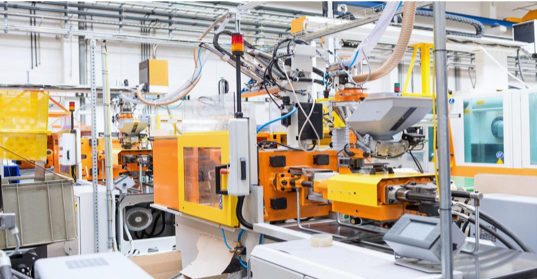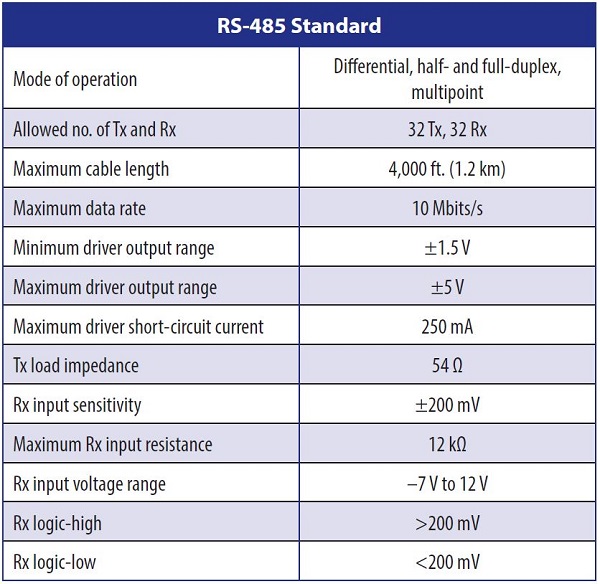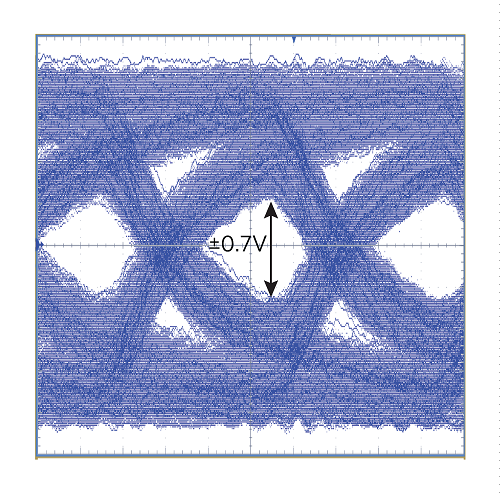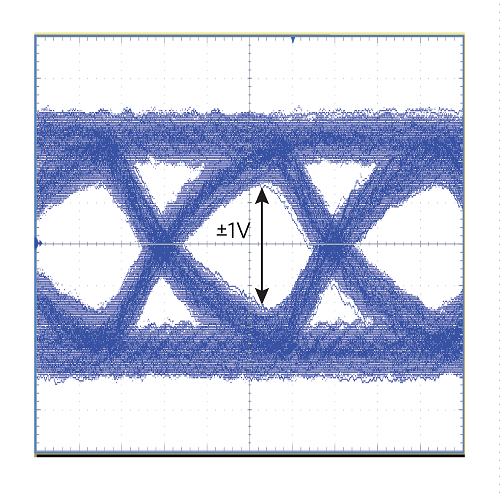BY MICHAEL JACKSON, Analog IC Design Engineer, and SEAN LONG, Director, Applications, Industrial & Healthcare Business Unit
Maxim Integrated
www.maximintegrated.com
As modern industrial environments become ever larger and more complex, production engineers are challenged in the design and layout of automated industrial process control systems, particularly regarding communications network reliability, range, and data rates. However, one network protocol that has withstood the test of time in harsh, noisy environments is RS-485, and recent advances in signal conditioning and processing will ensure that it continues to do so.
This article will briefly review the original RS-485 specification and present its relative strengths and weaknesses. It will then show how its capabilities are being extended to meet the demands of modern industrial network protocols.
The evolution of RS-485
For over 20 years, common network protocols such as PROFIBUS have used the RS-485 standard for transmission of electrical signals across physical media in harsh, electrically noisy, industrial environments (Fig. 1 ).

Fig. 1: Industrial environments are increasingly complex yet remain harsh and electrically noisy, challenging designers to get more out of their network interfaces.
However, as these network protocols have developed and evolved, the original RS-485 specification is being pushed to its limits (and beyond).
The original ANSI/TIA/EIA-485-A-1998 standard, now commonly known as RS-485, was approved in March 1998. RS-485 is a bidirectional, half-duplex standard featuring multiple “bussed” drivers and receivers in which each driver can relinquish the bus. RS-485 is an electrical-only, physical-layer (PHY) standard that relies upon differential signaling for noise immunity, typically on a balanced transmission cable, such as unshielded twisted pair (UTP).
With a –7-V to 12-V bus common-mode range, receiver input sensitivity is ±200 mV, which means that to recognize a “mark” (logical 1) or “space” (logical 0), a receiver must see signal levels above 200 mV or below –200 mV. Maximum receiver input impedance is 12 kΩ, and the driver output voltage is ±1.5 V minimum, ±5 V maximum. Fig. 2 lists the key specifications in the original RS-485 standard.

Fig. 2: The original RS-485 specification had a maximum data rate of 10 Mbits/s, achievable over short distances of 10 m to 15 m. Modern implementations achieve up to 40 Mbits/s over a few meters.
RS-485 advantages and disadvantages
RS-485 is commonly used for signal transmission between equipment in industrial environments because of its differential nature, which ensures high noise immunity in the harsh and noisy electric/magnetic fields typical of a factory setting. However, while the original standard was defined to operate at speeds up to 10 Mbits/s and at distances up to 1.2 km, these could not be simultaneously achieved. The maximum data rate is achievable over relatively short distances (10 m to 15 m). A rule of thumb to estimate the trade-off between the data rate and distance is that the product of the data rate, in bits per second, and distance, in meters, should not exceed 1 × 108 .
The requirement of industrial network protocols to operate at increasing data rates means that designers of modern RS-485 transceivers have pushed the original specification well beyond its original limit. It is not uncommon for modern transceivers to work at speeds that are multiples of the original specification — for example, 30 Mbits/s to 40 Mbits/s. These data rates are only achievable over relatively short distances (on the order of a few meters). However, the scale and complexity of modern process control systems requires signals to travel at higher speeds over medium distances (up to 100 m). To achieve this, the implementation of RS-485 needed to be re-examined.
Higher speeds over longer distances
Engineers noted that inter-symbol interference places the main limit on the maximum distance for RS-485 communications and that pre-emphasis can very effectively reduce this interference. Pre-emphasis is applied at the source of a transmitted signal, before the electrical channel, and improves the signal quality at the destination. The technique is common. In IC-layout programs, for instance, pre-emphasis adjusts the line widths to compensate for etch-rate variations that occur around corners. In disk-drive controllers, pre-emphasis compensates for poor frequency response near the center of the disk. Another type of pre-emphasis reduces tape hiss by boosting low-level signals in the middle- and high-frequency audio bands when recording and then reversing this process during playback.
Based on this finding, engineers developed RS-485 transceivers that incorporate internal pre-emphasis to further extend the capabilities of modern devices beyond their already advanced performance and far beyond the original specification. For example, a modern device is shown to be able to transmit over 100 Mbits/s over 10 m (Fig. 3 ).

Fig. 3: A modern RS-485 transceiver can achieve 100 Mbits/s over 10 m using Cat5e UTP cable with a good eye opening. (Scale of 2.5 ns/div)
As illustrated by the differential voltage levels of approximately ±2 V (measuring well above the minimum ±200 mV specified in the standard) in the eye diagram illustrated (Fig. 3 ), this device achieves a data rate of 100 Mbits/s over 10 m of Cat5e cable (and potentially over even longer distances depending on the choice of cable selected).
It’s also possible to get relatively high data transmission rates over longer factory network cable runs: up to 50 Mbits/s over 100 m of cable. Although not quite as distinct, the opening of the eye at this speed (approximately ±0.7 V) is still greater than the minimum voltage levels defined by the original RS-485 standard (Fig. 4 ).

Fig. 4: Over longer factory cable runs of up to 100 m, RS-485 can achieve 50 Mbits/s, again using Cat5e, though the eye opening may not be as distinct. (Scale at 5ns/div)
Using pre-emphasis, the performance of the transceiver — in this case, the Maxim Integrated MAX22500E — can be improved further over these longer distances (Fig. 5 ).

Fig. 5: Using pre-emphasis, the eye opening improves dramatically when operating at 50 Mbits/s over 100 m, going to ±1 V from ±0.7 V. (Scale at 5ns/div)
The speed and distance are the same as for Fig. 4 , but enabling the pre-emphasis feature increases the voltage levels so that the opening of the eye in the diagram is visibly more distinct.
This ability to enable pre-emphasis for data transmission over longer distances provides equipment designers with an extra degree of flexibility in achieving their desired level of speed-versus-distance performance using the RS-485 interface.
Other features to expect from modern RS-485 devices such as the MAX22500E include a –15-V to 15-V common-mode range and integrated ESD protection to ±15-kV ESD protection (Human Body Model), ±7-kV IEC 61000-4-2 Air-Gap ESD protection, ±6-kV IEC 61000-4-2 contact discharge ESD protection, and short-circuit protection of the driver outputs.
Conclusion
Although RS-485 is robust and reliable, there is a significant trade-off to be made between the speed and distances attainable. Modern transceivers use pre-emphasis and other techniques to provide reliable transmission of data up to 100 Mbits/s over 10 m of cable and up to 50 Mbits/s over 100 m in either full- or half-duplex mode. This means that designers of industrial automation and control equipment can confidently plan for the continued use of RS-485 as a communications interface in complex industrial environments for the foreseeable future.
Advertisement
Learn more about Maxim Integrated








